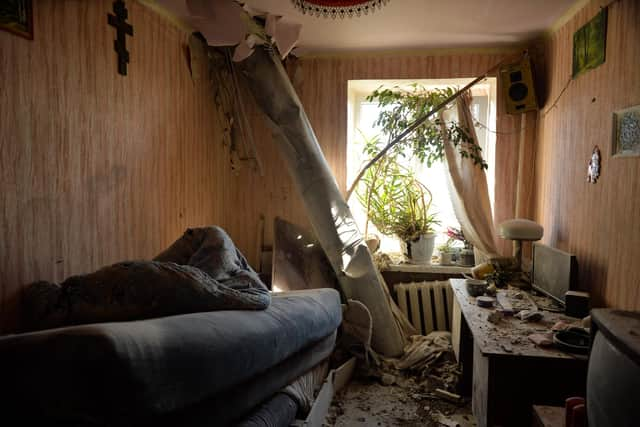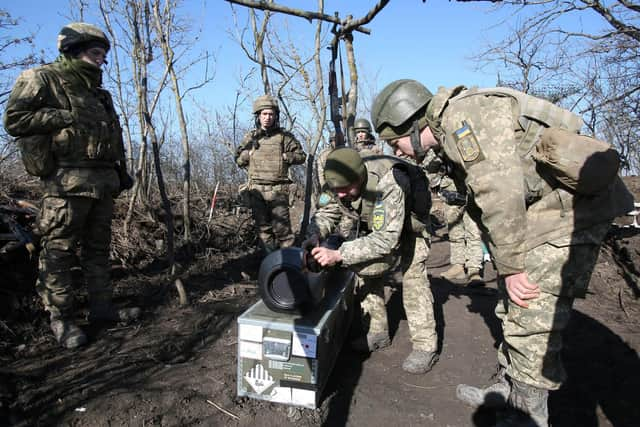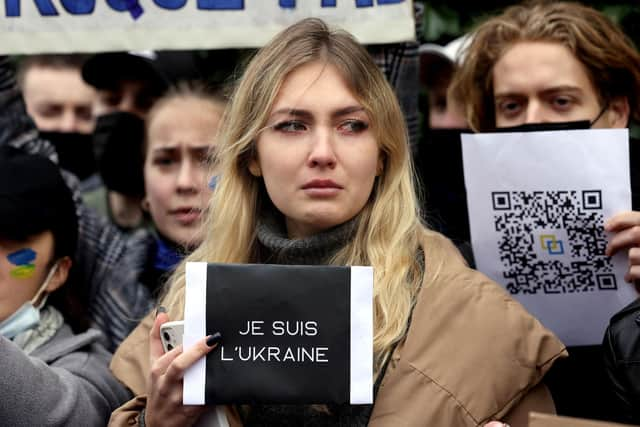Russian invasion: Ukraine's army is vastly outnumbered and outgunned by Vladimir Putin's forces but it could make a stand in the cities – Lt Col Stuart Crawford
The writing had been on the wall for some time, flagged up by US and UK intelligence sources months ago. Perhaps the only surprise is that nobody in authority seems to have taken their considered intelligence reports and predictions seriously.
Cutting through the fog of information, misinformation, and disinformation, it would appear that, after a barrage of air-delivered munitions, cruise missiles, and conventional artillery, Ukrainian defences – such as they were – were suppressed.
Advertisement
Hide AdAdvertisement
Hide AdRussian and Belorussian armoured columns are now thrusting into Ukrainian territory in a classic blitzkrieg operation, seeking to disrupt, dislocate, and dismay. The rest of the world looks on, temporarily stunned.
What are the chances of Ukraine being able to withstand the Russian attack? Limited at best, it would seem, although Vladimir Putin’s ultimate aim is not yet clear. Is it only eastern Ukraine that he wants to “de-militarise and de-Nazify”, or has he designs on occupying the whole country? Time will tell.
In the meantime, what options does Ukraine have for its defence? A quick look at the balance of forces, on paper at least, indicates that it is vastly outnumbered and outgunned.
Overall, the Russian armed forces boast some 850,000 active-duty personnel, the fourth largest in the world. Ukraine’s 250,000-odd pale in comparison. In the air, Russia outnumbers Ukraine by nearly 13 to one, and in tanks has some 12,500 to Ukraine’s 2,600. The imbalance continues across all branches and services.


These are overall figures though, and do not necessarily reflect the situation within the immediate area of operations. But it’s probably fair to surmise that the Ukrainians are at a considerable disadvantage in terms of both numbers and in terms of training and equipment, although not, of course, necessarily in terms of courage.
Against this background, I would say that Ukraine is unlikely to be successful if it chooses to go toe-to-toe with the Russian behemoth in open, conventional warfare, and indeed would be in dire danger of being overwhelmed.
If a territorial stand is to be made, then the great natural barrier of the River Dniepr would seem to be the biggest and best obstacle to further Russian advances if Putin decides to go for the whole of Ukraine, but consolidating defences there would demand the ceding of much territory.
More effective, perhaps, but no less terrifying might be the tactical move to concentrate Ukrainian defence on cities and towns, not the open countryside. Modern armies tend to try to avoid urban warfare at all costs, and the reasons are obvious.


Advertisement
Hide AdAdvertisement
Hide AdConflict in built-up environments where fighting can literally be from house to house, if not room to room, absorbs multiple battalions and demands huge logistic resources. Many of the advantages of a superior enemy, as in artillery and air power for example, can be negated by the close nature of the combat.
The downside for the Ukraine, of course, would be wholescale destruction of its cities and the likelihood of enormous civilian casualties. The Russians, on the other hand, will still be only too aware of their experiences at Stalingrad and Berlin. So it might be another case of employing asymmetric warfare, where the defender chooses not to play to the enemy’s strengths but to his weaknesses, although it is still a major risk.
What seems to be clear is that Ukraine cannot, in the short term at least, anticipate much practical military help in terms of troops or air assets coming to its aid from its erstwhile allies.
Not being a member of Nato, Article 5 of the North Atlantic Treaty – which basically states that an attack on one Nato member is to be regarded as an attack upon all – does not apply. Whether being a Nato member would make any difference anyway is a moot point; would the USA contemplate a possible nuclear war with Russia to defend a far-off ally? I have my doubts, but perhaps I’m just being overly cynical.


So all Ukraine can expect from outside is more military aid in the form of anti-tank missiles, helmets, and body armour and the like, and much wringing of hands and statements of “solidarity” from assorted political figures standing on the sidelines.
Apart from those, I fear Ukrainians are pretty much on their own for now. I have no doubts that they are a brave and courageous nation and will do their best, but the prognosis is not hopeful.
If the worst comes to the worst, and all of Ukraine is over-run and occupied by Russia, what then? Much depends on Putin’s agenda, which only he seems to know.
If there is indeed a list of individuals who are in danger of arrest and/or deportation, then there is likely to be a resistance of sorts. It’s perfectly possible that a guerrilla underground army could spring up, dedicated to strike back, much as happened in occupied parts of Europe during the Second World War.
Advertisement
Hide AdAdvertisement
Hide AdSuch work is fraught with danger, though, and on its own might not achieve a great deal. Wars and campaigns are usually won and lost by the big battalions.
In the end, hostilities will be brought to a close by negotiation, as they always are. Here at present Putin has the upper hand, for he has taken the initiative and his gains will be useful bargaining chips in what follows the conflict.
Ultimately I suspect Russia’s gains will be limited to the areas of eastern Ukraine occupied by ethno-Russians, to be added to previous de facto annexations in Donbas and Crimea. For Putin I suspect that will be job done. For Ukrainians, however, the future is uncertain.
Stuart Crawford, a former Lieutenant Colonel in the Royal Tank Regiment, is a defence and military commentator
A message from the Editor:
Thank you for reading this article. We're more reliant on your support than ever as the shift in consumer habits brought about by coronavirus impacts our advertisers.
If you haven't already, please consider supporting our trusted, fact-checked journalism by taking out a digital subscription.
Comments
Want to join the conversation? Please or to comment on this article.
